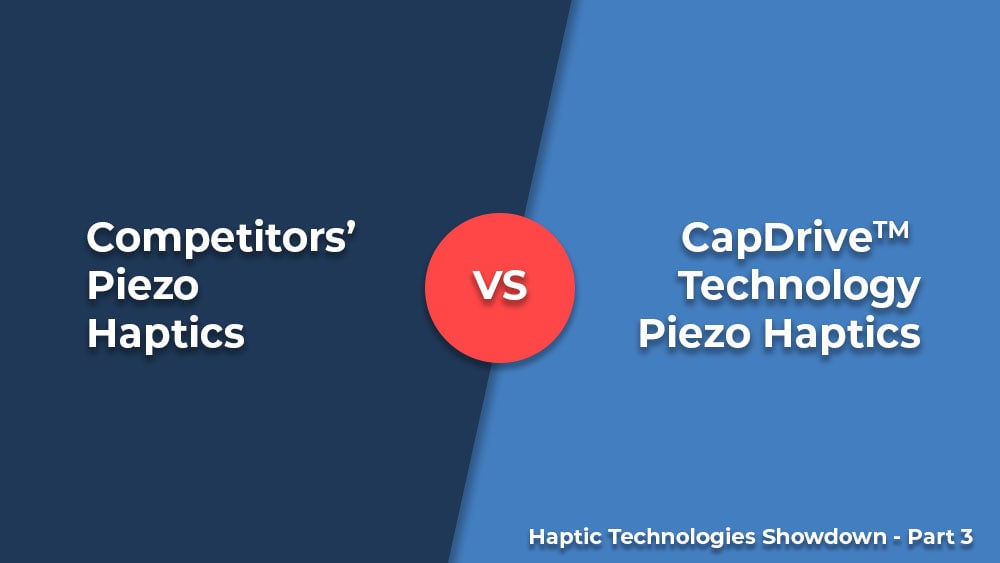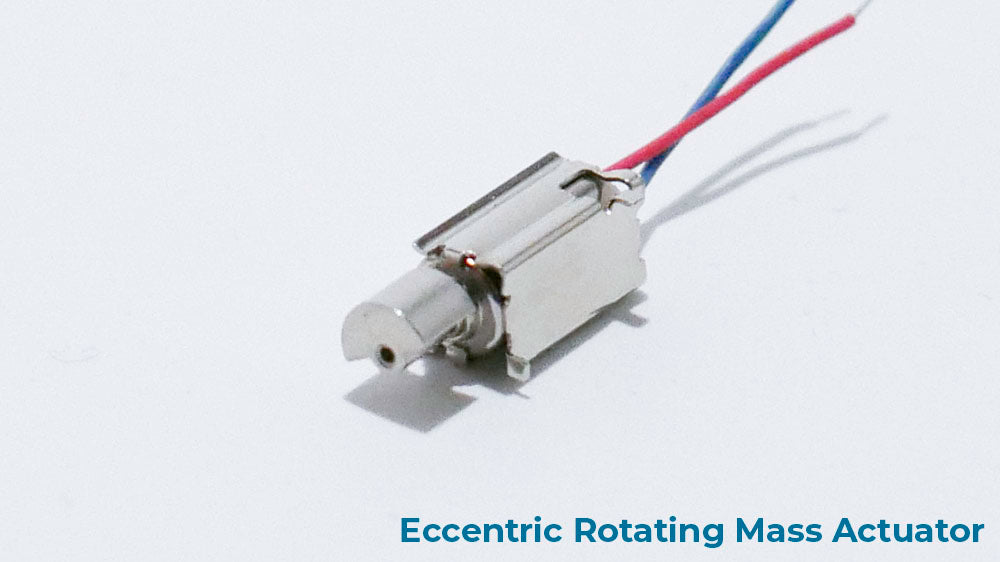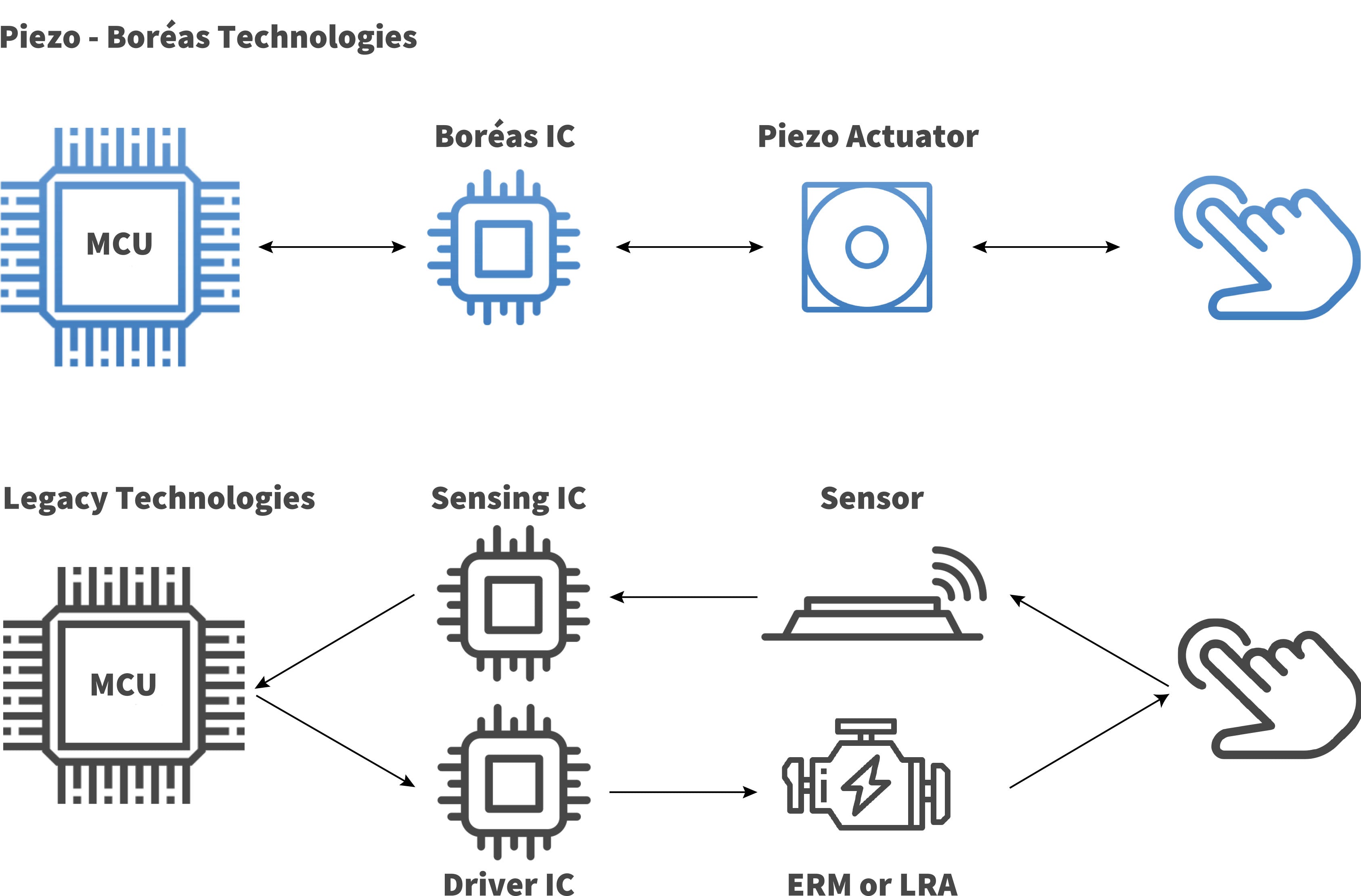
This blog article is the first of a series of three haptic technologies comparison. You can read the two following parts here:
Haptic feedback isn’t new. We must go back to the ’60s to see the first iteration of devices using vibration feedback to send information to the users. The system used to create vibrations back in those days is still used today to create basic tactile feedback in low-cost devices. Eccentric rotating mass (ERM), often called vibration motors, haptic systems are composed of an electrical motor that rotates an off-centred mass at high frequency. The same concept from the ’60s is still used today, but the technology was miniaturized to fit smaller devices.

Nowadays, eccentric rotating mass actuators are still used in many devices to create haptic feedback due to their low cost, but they are starting to get replaced by better performing technologies. We now live in a digital world and we’re surrounded by devices with touchscreens. Companies around the world are developing new technologies to improve the user experience of their devices, hence the development of better haptic technologies.
One of those higher-performing technologies is the piezoelectric haptic actuator. Based on the piezoelectric effects of certain materials, this technology brings many advantages over ERM motors. Instead of rotating an off-center mass, piezo solutions need to send high-voltage power through the actuator material with a piezo driver to deform it and create tactile feedback. We’ll see what differentiates piezo and ERM haptics and what you should use in your application.
Piezo Haptics Create Stronger Tactile Feedback
Acceleration, in haptics, is related to the strength of the tactile feedback you can feel. The higher acceleration the actuator can reach, the stronger the haptic feedback it can generate.
ERM systems are fairly limited in the acceleration they can reach and it’s easy to understand why. The electric motor needs to accelerate a mass in order to create vibration. To do so, it needs to break the mass inertia and ramp up the speed to the optimal frequency. The mass acceleration isn’t instantaneous. This is why ERM motors produce unrefined rumble.
Piezo actuators, on the other hand, doesn’t have this mechanical limitation. Since the vibration doesn’t rely on mass rotation, the actuator vibrates as soon as the high voltage reach the piezo material. Therefore, piezo actuators can create much stronger and crispier feedback than ERM motors.
ERM Solutions Consume Up to 20 Times More Energy Than Our Piezo CapDriveTM Technology.
Power Consumption: ERM vs CapDriveTM Technology Piezo Haptics
Another area where piezo haptics have a major advantage is in total power consumption. Piezo actuators are very power efficient. Unfortunately, the actuators’ low power consumption was nullified by sub-performing piezo drivers. Things have now changed since the release of our CapDriveTM Technology. The BOS1901, our first piezo haptic driver integrated circuit based on CapDriveTM, is the most efficient piezo driver on the market. Our technology makes piezo the lowest power-consuming haptic technology available.
Eccentric rotating mass consumes a lot of power. In fact, it can use up to 20 times more power than our BOS1901 piezo driver IC.
If you are looking to integrate haptics into a device with a limited power source, like a mobile device, you should look at piezo haptics instead of an ERM solution.
Vibration Motors Have Slow Reaction Time While Piezo Is Near Instantaneous
Haptic feedback needs to have perfect timing to create the best feedback possible. The faster reaction times translate to crisper and more refined tactile feedback. Vibration motors take more time to accelerate the rotating mass and reach their peak frequency (optimal zone for feedback). Plus, they need to decelerate the mass after the effect. ERM normally takes up to 50 milliseconds to reach its peak frequency. The acceleration and deceleration delays create small soft undesirable vibrations at both the end and beginning of the effect.
Piezo actuators have a near-instantaneous reaction time of less than 2 milliseconds. This means you won’t experience the small soft undesirable tactile feedback of the acceleration and deceleration time. Piezo haptics creates crisper and more refined feedback. The limiting factor for piezo actuators is actually the piezo driver response time. Our BOS1901 piezo driver has the fastest response time in the industry, under 6 milliseconds.
Piezo Haptics Save a Lot of Space Over ERM Systems
ERM vibration motor haptic systems are bigger and take up more space than piezo haptic solutions. While it’s true that ERM drivers are smaller than piezo drivers, the big difference lies in the actuator’s size. Piezo actuators are smaller than ERM and offer bigger haptic feedback.
If you need a compact solution, you should choose piezo haptics over vibration motors.
Taking Full Advantage of the Piezo Effect to Offer Integrated Force Sensing

The piezo effect is reversible. You can apply high voltage into a piezo material to make it move, but the piezo material can also produce an electrical charge when it is deformed. When you press on a piezo actuator, you slightly deform the piezo material. The actuator then produces an electrical current. Our CapDriveTM Technology piezo drivers can detect that electric current. They can detect force and trigger feedback from the same actuator.
Eccentric rotating mass haptic solutions can only trigger haptic feedback. If you need to detect force you’ll need a complete force sensing hardware system beside your haptic system.
This means that if you need a haptic solution that triggers when force is applied, like replacing a mechanical button, you can eliminate the sensing hardware and rely solely on one piezo actuator coupled with one of our piezo drivers. Ideal for saving space! It’s actually what we did with our SmartClik buttonless phone prototype.
High-Definition Haptics vs. Basic Rumble
Piezo actuators can generate more advanced haptic effects. Like audio speakers, they use an electrical waveform signal from an amplifier (the piezo driver) and they can be operated with a broad range of frequencies and amplitudes to generate an infinity of various tactile effects. You can customize the haptic feedback depending on your application and create rich and detailed feedback. This is what we call high-definition haptic feedback.
ERM solutions, on the other hand, have a very limited frequency range to create optimal feedback. This means you have a very limited range of haptic effects. ERM motors are limited to low-quality rumbles.
Piezo haptics opens the possibilities for more advanced effects that ERM can’t replicate. Piezo haptics is perfect for various applications where you need different tactile effects like AR/VR, automotive safety alerts, button replacement, etc.
Boréas Technologies’ Piezo IC CapDriveTM Technology vs. Eccentric Rotating Mass (ERM)
| Features | ERM | Piezo - CapDriveTM |
| Acceleration (g)* | 0.6 | 2.5 |
| Power Consumption | High | Low |
| Start-Up Time [ms] | 50 | 0.3 |
| Footprint Size | Big | Miniature |
| Integrated Force Sensing | No | Yes |
| HD Haptics | No | Yes |
*with 100g mass. Acceleration is related to feedback strength. Higher number = Stronger feedback
Experiment with the Best Piezo Haptic Driver Integrated Circuit Today
The BOS1901 Development Kit is available to easily test the possibilities of piezo haptics. The Kit comes with two BOS1901 piezo haptic driver IC, a selection of piezo actuators and easy GUI software to launch various tactile effects easily.


Leave a comment